THE BIPLANE (PARALLEL) RIG
A brief explanation.
The working principle of the biplane (parallel) rig.
Our DUO 425 was the first beach catamaran with a parallel rig. After some theoretical work I decided to give it a try. In this time you could get a windsurf rig for about 80 German Marks.
I will try to explain the advantages of this rig without getting to theoretical. The biggest advantage is more sail area in respect to a sloop rig (jib and main sail) with a lower center of effort.
Result: The boat can be sailed in higher wind speeds as a sloop rig. Which means more power in the sail resulting in a better speed. A parallel rig generates also more power as a sloop.
First take a look at the drawing.
Wind speed VT is at 90 degree to the boat. The projection of the wind (blue lines) shows a wind speed of 10 kn. For different boat speeds ( V) the resulting apparent wind increases shown in the red (VA). Means more power in the sail, resulting in a faster boat. This means, the lighter the boat is, the higher is the basic speed V.
The wind ward sail is set at a bigger angle as the lee wards sail. The conservation of mass is a fundamental concept of physics . When a given amount of air enters the area between the sails, (For clarity of the diagram, no vector diagram is shown on the sails how the forward force is generated the same amount has to leave the gab.

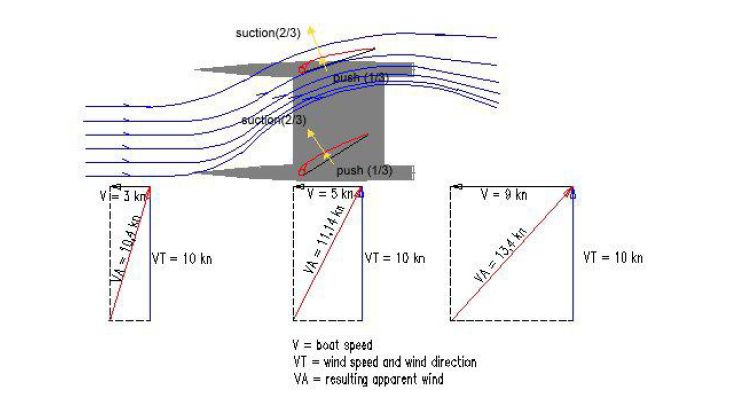
Though the narrowing between the sails the
velocity increases. As a result the „suction“ power on the wind ward sail increases and the „pushing“ power on the lee sail increases.
As a consequence the total force of the sails increases which means more speed.
How fast can you go? This depends on how far forward the apparent wind fell onto the
sail. When the sail on the leading edge fells in, power is lost. This will be the absolute limit. In fact the sails lose power before because the angle of attack of the sail gets to shallow for optimum lift (CL) generation.
A lot is written about blanked out leeward sails. If the weight to sail area ratio (power
ratio) is to high. With other words, if the boat is to heavy, forget to use a parallel rig.
The triangulation shows from left to right, a slow till a fast boat. By this it is clear that the
biplane has an advantage. Observe, that the windward sail has a greater angle as the sail on the lee side.
Strong points of the rig:
For the same sail area, a parallel has the same sail area on lower spars thus the CE of the sails is lower. rig CE is lower, meaning that the boat is more stable, less risk for capsizing.
Dividing sail area between two rigs means each sail is smaller, so the sails are more easy to handle.
The sails can have sleeves. Meaning a better aerodynamic shape of the leading edge. Result again more powerful.
Normally the sails are on free standing masts. Simpler deck layout and less windage. General less clutter. And a nice side effect, no nice from the rigging in port or for anchor.
In high wind the boat can be sailed as an Atlantic or a Pacific proa, which makes the boat extreme stable for the size.
Actual, increasing as Pacific proa the effective beam by 50%*.
The Atlantic proa is the brainchild of Richard C. Newick. The sails are to windward. Other hull is at the lee side. Again using the full beam of the boat, and again increasing the stability by 50%*
*If only one sail is used the increase of stability is 100%
Here is the DUO 425 sailing in Lelystad, the Netherlands. This boat reached a
speed of 32 kn.
Advantage of the rig
Lower center of effort as a sloop rig. The boat is more stable and because the sail can handle a higher wind speed, meaning the boat can be faster.
With the free standing rig. Less clutter and windage. Meaning again a faster boat.
Shorting sail can be done the regular way, or by rotating the masts. An easy and safe operation.
velocity increases. As a result the „suction“ power on the wind ward sail increases and the „pushing“ power on the lee sail increases.
As a consequence the total force of the sails increases which means more speed.
How fast can you go? This depends on how far forward the apparent wind fell onto the
sail. When the sail on the leading edge fells in, power is lost. This will be the absolute limit. In fact the sails lose power before because the angle of attack of the sail gets to shallow for optimum lift (CL) generation.
A lot is written about blanked out leeward sails. If the weight to sail area ratio (power
ratio) is to high. With other words, if the boat is to heavy, forget to use a parallel rig.
The triangulation shows from left to right, a slow till a fast boat. By this it is clear that the
biplane has an advantage. Observe, that the windward sail has a greater angle as the sail on the lee side.
Strong points of the rig:
For the same sail area, a parallel has the same sail area on lower spars thus the CE of the sails is lower. rig CE is lower, meaning that the boat is more stable, less risk for capsizing.
Dividing sail area between two rigs means each sail is smaller, so the sails are more easy to handle.
The sails can have sleeves. Meaning a better aerodynamic shape of the leading edge. Result again more powerful.
Normally the sails are on free standing masts. Simpler deck layout and less windage. General less clutter. And a nice side effect, no nice from the rigging in port or for anchor.
In high wind the boat can be sailed as an Atlantic or a Pacific proa, which makes the boat extreme stable for the size.
Actual, increasing as Pacific proa the effective beam by 50%*.
The Atlantic proa is the brainchild of Richard C. Newick. The sails are to windward. Other hull is at the lee side. Again using the full beam of the boat, and again increasing the stability by 50%*
*If only one sail is used the increase of stability is 100%
Here is the DUO 425 sailing in Lelystad, the Netherlands. This boat reached a
speed of 32 kn.
Advantage of the rig
Lower center of effort as a sloop rig. The boat is more stable and because the sail can handle a higher wind speed, meaning the boat can be faster.
With the free standing rig. Less clutter and windage. Meaning again a faster boat.
Shorting sail can be done the regular way, or by rotating the masts. An easy and safe operation.

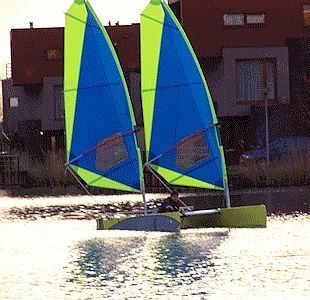
Resonance80 H.J. Sass design from 1983. Rotating masts.
DUO 480 New Zealand DUO 800 India
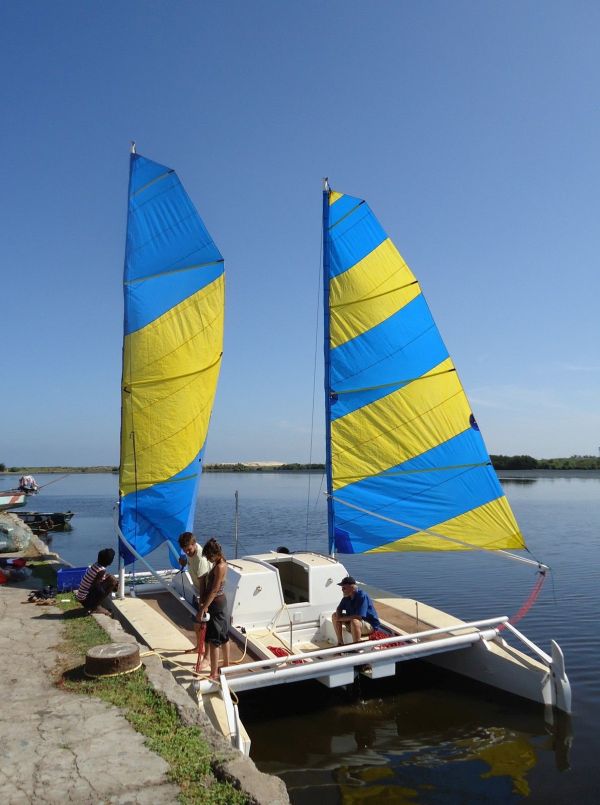
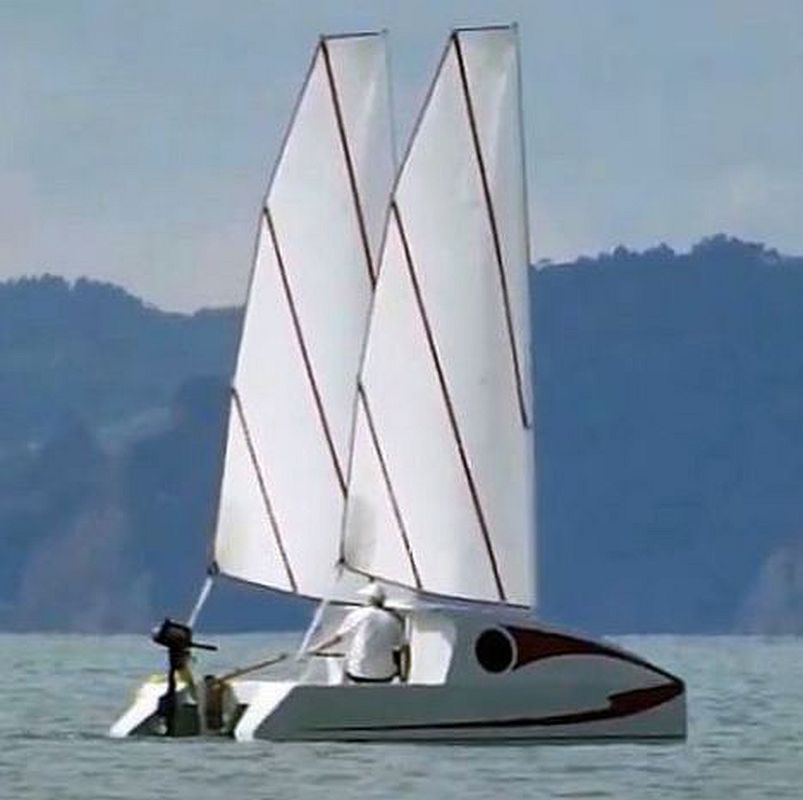
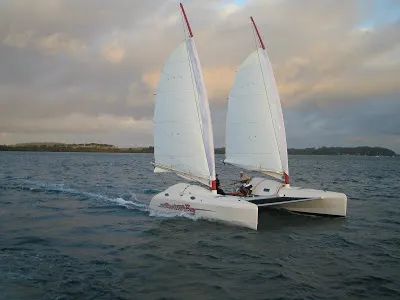
Some Videos
Yves Parlier Hydraplaner
<https://www.youtube.com/watch?v=AY0ssDA70gY>
DUO 480 New Zealand
https://www.youtube.com/watch?v=PiTbOKIuxlY
Radical Bay2000
<https://www.youtube.com/watch?v=Dq_wUxR0sdI>
Yves Parlier Hydraplaner
<https://www.youtube.com/watch?v=AY0ssDA70gY>
DUO 480 New Zealand
https://www.youtube.com/watch?v=PiTbOKIuxlY
Radical Bay2000
<https://www.youtube.com/watch?v=Dq_wUxR0sdI>
Radical Bay200 by Schionning
BACK TO DESIGNS
BIBLIOGRAPHY
Aero-hydrodynamics of sailing by C.A. Marchaj
Aero-hydrodynamics of sailing and the performance of sailing yachts by Fabio Fossati
High Speed Sailing, design factors by Joseph Norwood,Jr
UP

